Charles Dickens in Italy
 In 1844 Charles Dickens went to Italy for a year. Based in Genoa, he travelled around, going as far south as Paestum, and published a book on his travels, Pictures from Italy
(1846) in which he refrained from commenting on the government of the country (courtesy to his hosts) and on its art (too much published already). He hoped for readers who were fair (complexion), very cheerful (eyes), not supercilious (nose), smiling (mouth), beaming (visage) and extremely agreeable (general expression). But apart from welcoming Dickens the man, how did Italians like his novels? This question has been addressed in a monumental two-volume survey, The Reception of Charles Dickens in Europe
, (Bloomsbury 2013), edited and introduced by Michael Hollington (ex-UNSW). It is reviewed at length in this week’s TLS
(April 11, pp. 12-13), where the reviewer notes the editor’s regretful demolition of the claim, made in an untraceable Kazakh journal by an unidentifiable author, that Dickens met Dostoevsky in London in July 1862.
In 1844 Charles Dickens went to Italy for a year. Based in Genoa, he travelled around, going as far south as Paestum, and published a book on his travels, Pictures from Italy
(1846) in which he refrained from commenting on the government of the country (courtesy to his hosts) and on its art (too much published already). He hoped for readers who were fair (complexion), very cheerful (eyes), not supercilious (nose), smiling (mouth), beaming (visage) and extremely agreeable (general expression). But apart from welcoming Dickens the man, how did Italians like his novels? This question has been addressed in a monumental two-volume survey, The Reception of Charles Dickens in Europe
, (Bloomsbury 2013), edited and introduced by Michael Hollington (ex-UNSW). It is reviewed at length in this week’s TLS
(April 11, pp. 12-13), where the reviewer notes the editor’s regretful demolition of the claim, made in an untraceable Kazakh journal by an unidentifiable author, that Dickens met Dostoevsky in London in July 1862.








